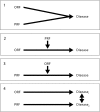Interaction of occupational and personal risk factors in workforce health and safety
- PMID: 22021293
- PMCID: PMC3487655
- DOI: 10.2105/AJPH.2011.300249
Interaction of occupational and personal risk factors in workforce health and safety
Abstract
Most diseases, injuries, and other health conditions experienced by working people are multifactorial, especially as the workforce ages. Evidence supporting the role of work and personal risk factors in the health of working people is frequently underused in developing interventions. Achieving a longer, healthy working life requires a comprehensive preventive approach. To help develop such an approach, we evaluated the influence of both occupational and personal risk factors on workforce health. We present 32 examples illustrating 4 combinatorial models of occupational hazards and personal risk factors (genetics, age, gender, chronic disease, obesity, smoking, alcohol use, prescription drug use). Models that address occupational and personal risk factors and their interactions can improve our understanding of health hazards and guide research and interventions.
Figures









References
-
- Schulte PA. Characterizing the burden of occupational injury and disease. J Occup Environ Med. 2005;47(6):607–622 - PubMed
-
- Loeppke R. The value of health and the power of prevention. Int J Workplace Health Manag. 2008;1(2):95–108
-
- Ringen K, Smith WJ. Occupational diseases and equity issues. Va J Nat Resources L. 1983;2:213–231
-
- Richter J. Taking the worker as you find him. Md J Contemp Leg Issues. 1997;8:189–236
-
- Poulter SR. Genetic testing in toxic injury litigation: the path to scientific certainty or blind alleys. Jurimetrics. 2001;41:211–239
MeSH terms
Substances
LinkOut - more resources
Full Text Sources
Medical

